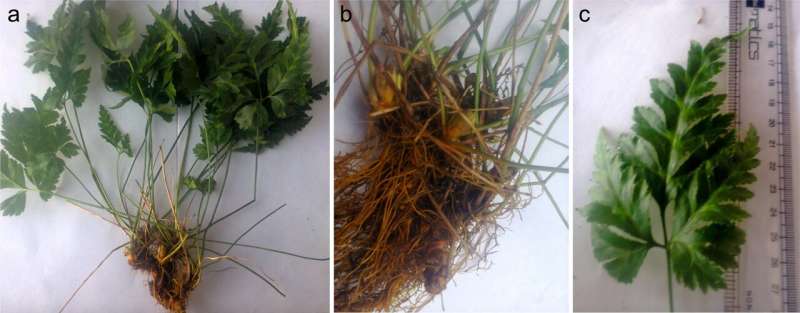This article has been reviewed according to Science X's editorial process and policies. Editors have highlighted the following attributes while ensuring the content's credibility:
fact-checked
proofread
'Mishmi Tita' research provide an overview of the medicinal herb's uses and conservation

Coptis teeta Wall. (C. teeta), commonly known as "Mishmi Tita," is a medicinal herb of considerable value traditionally used for treating various health conditions. This endangered plant, listed in the Red Data Book, is found in India, Nepal, Bhutan, and China.
The present review aims to comprehensively summarize the traditional uses, pharmaceutical applications, and phytochemical properties of C. teeta, thereby providing a foundation for future research, conservation, and cultivation efforts. The findings are published in the journal Future Integrative Medicine.
A thorough literature search was conducted on PubMed, Google Scholar, Research Gate, SciFinder, and the ISI Web of Knowledge using terms such as "Coptis teeta," "Coptis teeta Wall.", "Mishmi tita," "Rhizoma coptidis," "Chinese medicine from Coptis teeta," and "Traditional uses of Coptis teeta." A comprehensive examination of 69 articles published between 1982 and 2023 was performed to explore the properties and traditional applications of C. teeta. The review focused on identifying the range of pharmacological effects, the active compounds within the plant, and traditional medicinal uses.
Various tribes in Arunachal Pradesh, including the Adi, Galo, Memba, Nyishi, and Tagin, utilize C. teeta to treat malaria, stomach ache, diarrhea, skin conditions, eye disorders, and gastrointestinal issues. For instance, the Nyishi people use rhizomes for treating eye disorders and digestive issues, while the Adi community employs leaf and root decoctions for blood clotting and malaria. C. teeta's use in treating gastrointestinal problems and eye disorders is widespread, indicating its significant role in traditional medicine.
In China, the Lhoba people of Tibet and other communities use C. teeta roots to stop bleeding, relieve pain, and treat intestinal diseases, anthrax, and dysentery. Rhizoma coptidis, a dried rhizome used in traditional Chinese medicine, includes C. teeta and is employed to clear heat, dampness, and toxicity, and to treat conditions such as high fever and heartburn. Its wide application in Chinese medicine underscores its therapeutic importance.
In Myanmar, C. teeta is used to relieve constipation, stimulate digestion, lower fever, treat malaria, and boost vitality. When combined with Piper nigrum, it is also used to treat cough and asthma. This highlights the plant's versatile applications in traditional medicine across different cultures.
C. teeta contains several alkaloids such as berberine, palmatine, jatrorrhizine, coptisine, columbamine, and epiberberine. Berberine, the main constituent, is well-known for its broad range of pharmacological activities, including antimicrobial, anti-inflammatory, and antioxidant effects. The presence of these compounds underpins the plant's traditional and modern medicinal applications. The identification of 27 compounds in different parts of the plant emphasizes its rich chemical diversity and potential for pharmaceutical development.
Studies have shown that C. teeta significantly suppresses the growth of Staphylococcus aureus and other bacteria. Ethanolic and aqueous extracts of C. teeta have demonstrated substantial antibacterial activity against several strains, including Bacillus subtilis, Bacillus pumilus, and Escherichia coli. This highlights its potential as a natural antibacterial agent.
Traditional use of C. teeta for alleviating diarrhea and lowering blood pressure is supported by modern pharmacological studies indicating its effectiveness in these areas. These properties are particularly valuable for managing common health issues in traditional medicine.
The plant's compounds have been shown to reduce inflammation and manage diabetes, making it a potential candidate for treating these chronic conditions. Its anti-inflammatory properties are particularly beneficial in conditions where inflammation is a key factor.
The antioxidant properties of C. teeta, primarily due to berberine, contribute to its potential in preventing oxidative stress-related diseases. Additionally, some studies suggest its potential in cancer treatment, although more research is needed to fully understand its efficacy and mechanisms.
Due to its endangered status and the rapid loss of its natural habitat, C. teeta faces the risk of extinction. Efforts to conserve this species are crucial, and sustainable cultivation practices must be developed. Raising public awareness and encouraging local cultivation can help preserve this valuable medicinal plant. In Arunachal Pradesh, some local farmers and the Forest Department have initiated cultivation efforts, though these are still on a small scale. The plant's preference for acidic, moist soil and its ability to grow in various soil types make it a viable candidate for expanded cultivation.
To ensure the survival of C. teeta, comprehensive conservation strategies must be implemented. These include in-situ and ex-situ conservation, habitat protection, and the establishment of botanical gardens dedicated to cultivating endangered species. Public awareness campaigns and educational programs can also play a significant role in conservation efforts.
Future research should focus on exploring the full pharmacological potential of C. teeta, particularly its anticancer properties and other lesser-known effects. Detailed studies on its phytochemical constituents can lead to the discovery of new compounds with therapeutic benefits. Additionally, research on sustainable cultivation techniques and habitat restoration is essential to ensure the plant's long-term survival.
More information: Nilamoni Chelleng et al, Coptis teeta Wall.: A Comprehensive Overview of its Traditional Uses, Pharmacological Uses, Phytochemicals and Conservation, Future Integrative Medicine (2024). DOI: 10.14218/FIM.2023.00082
Provided by Xia & He Publishing Inc.



















